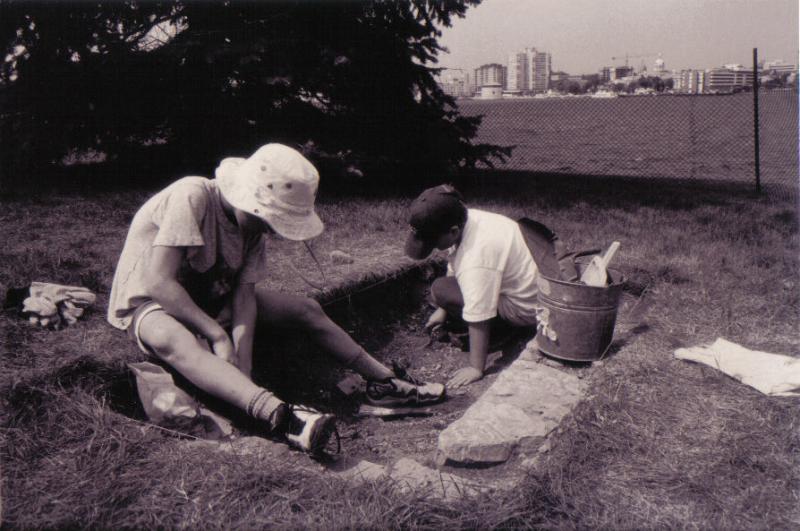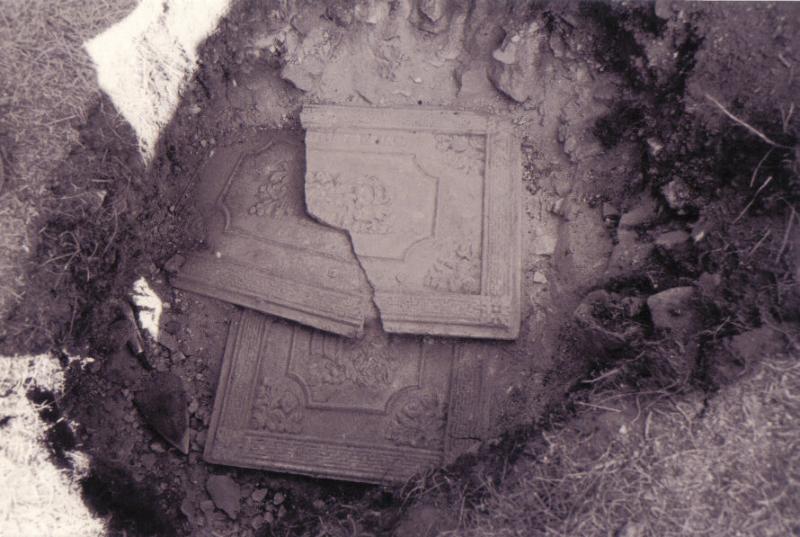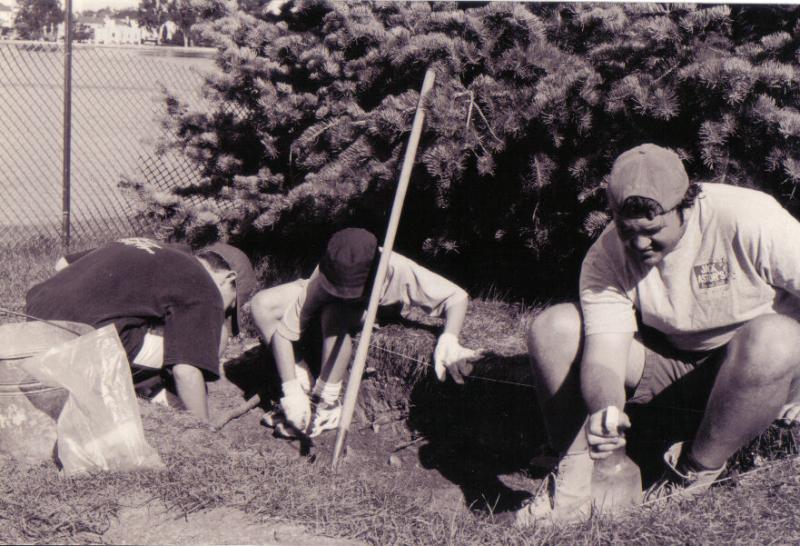 As a result of the successful 1998 program, the fourth season of the “Can You Dig It?”© Summer Archaeology Program was begun. A total of 52 participants assisted in all aspects of the excavation providing approximately 1,054 hours of field time, with ages ranging from 8 to16, as well as adults. The program was conducted for 5 one-week long sessions and 1 three evening and one-weekend session between July 5 and August 20. The Naval Cottages at the Royal Military College of Canada were located on the western portion of the Point, located on the western shore facing downtown Kingston.
As a result of the successful 1998 program, the fourth season of the “Can You Dig It?”© Summer Archaeology Program was begun. A total of 52 participants assisted in all aspects of the excavation providing approximately 1,054 hours of field time, with ages ranging from 8 to16, as well as adults. The program was conducted for 5 one-week long sessions and 1 three evening and one-weekend session between July 5 and August 20. The Naval Cottages at the Royal Military College of Canada were located on the western portion of the Point, located on the western shore facing downtown Kingston.
The site of the Naval Cottages was chosen for the possibility of investigating the site to gather information on military and civilian occupation relating to the Dockyard Period of the first half of the 19th century was of interest. To date, the only formal archaeological excavations undertaken on Point Frederick was last year’s program, but still little is known of the development of the Dockyard from the workers' point of view. In addition, archival research has indicated that the cottages were constructed in 1822 and a destructive fire terminated occupation in one area in 1868, therefore providing an excellent period  with a known start and end to occupation. The 1868 fire destroyed the southerly six cottages and one additional was demolished to create a fire-break. These were completely removed in 1875 when the College was created and the surviving range of nine northerly cottages remained in use until 1910.
with a known start and end to occupation. The 1868 fire destroyed the southerly six cottages and one additional was demolished to create a fire-break. These were completely removed in 1875 when the College was created and the surviving range of nine northerly cottages remained in use until 1910.
In general as in 1998, a large number of artifacts were recovered and additional structural remains were encountered. The artifacts are representative of the late 18th and first half of the 19th century. Most of the artifacts, based on the context and their relative date, are associated with the construction, occupation and eventual destruction of the structures on the site dating between 1822 and 1868. Several interesting artifacts were recovered such as three cast iron stove sides with the maker’s mark “J. Van Norman U.C.”, a piece of decorative stonework,  keys, a straight razor, a 41st Regiment of Foot silver-plated button. Since the 41st Regiment of Foot was stationed in Kingston during the War of 1812 and left Canada in 1815, this begs the question of how this button turned up in an upper layer of the excavation.
keys, a straight razor, a 41st Regiment of Foot silver-plated button. Since the 41st Regiment of Foot was stationed in Kingston during the War of 1812 and left Canada in 1815, this begs the question of how this button turned up in an upper layer of the excavation.
Stratigraphically, the bulk of the lots relate to the fire and later demolition of the burned cottages. Three debris “pits” were identified and relate directly to fire collapse and post-fire demolition. The “pits” likely already existed in the form of the basements of the cottages. These are the source for the large quantities of artifacts, which for the most part have suffered the effects of the fire.

 As a result of the successful 1998 program, the fourth season of the “Can You Dig It?”© Summer Archaeology Program was begun. A total of 52 participants assisted in all aspects of the excavation providing approximately 1,054 hours of field time, with ages ranging from 8 to16, as well as adults. The program was conducted for 5 one-week long sessions and 1 three evening and one-weekend session between July 5 and August 20. The Naval Cottages at the Royal Military College of Canada were located on the western portion of the Point, located on the western shore facing downtown Kingston.
As a result of the successful 1998 program, the fourth season of the “Can You Dig It?”© Summer Archaeology Program was begun. A total of 52 participants assisted in all aspects of the excavation providing approximately 1,054 hours of field time, with ages ranging from 8 to16, as well as adults. The program was conducted for 5 one-week long sessions and 1 three evening and one-weekend session between July 5 and August 20. The Naval Cottages at the Royal Military College of Canada were located on the western portion of the Point, located on the western shore facing downtown Kingston. with a known start and end to occupation. The 1868 fire destroyed the southerly six cottages and one additional was demolished to create a fire-break. These were completely removed in 1875 when the College was created and the surviving range of nine northerly cottages remained in use until 1910.
with a known start and end to occupation. The 1868 fire destroyed the southerly six cottages and one additional was demolished to create a fire-break. These were completely removed in 1875 when the College was created and the surviving range of nine northerly cottages remained in use until 1910. keys, a straight razor, a 41st Regiment of Foot silver-plated button. Since the 41st Regiment of Foot was stationed in Kingston during the War of 1812 and left Canada in 1815, this begs the question of how this button turned up in an upper layer of the excavation.
keys, a straight razor, a 41st Regiment of Foot silver-plated button. Since the 41st Regiment of Foot was stationed in Kingston during the War of 1812 and left Canada in 1815, this begs the question of how this button turned up in an upper layer of the excavation.